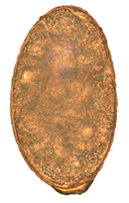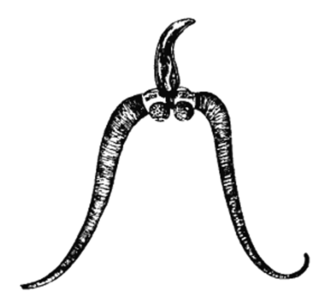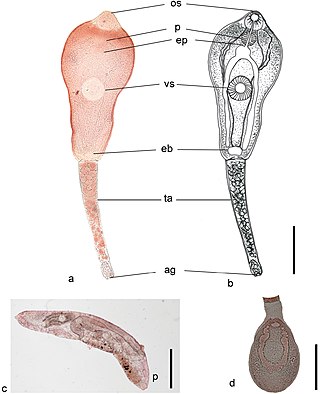
Trematodes are parasitic flatworms of the class Trematoda, specifically parasitic flukes with two suckers: one ventral and the other oral. Trematodes are covered by a tegument, that protects the organism from the environment by providing secretory and absorptive functions.
Ribeiroia is a genus of trematode parasites that sequentially infect freshwater snails in the family Planorbidae as first intermediate hosts, fish and larval amphibians as second intermediate hosts, and birds and mammals as definitive hosts. In North America, infection by Ribeiroia has been linked to amphibians with limb malformations. The connection between parasitic infection and limb malformations has generated questions about (a) whether parasite-induced malformations in amphibians are increasing, and (b) the consequences of such abnormalities for amphibian population conservation.

Trichobilharzia regenti is a neuropathogenic parasitic flatworm of birds which also causes cercarial dermatitis in humans. The species was originally described in 1998 in the Czech Republic and afterwards it was detected also in other European countries, e.g. Denmark, Germany, France, Iceland, Poland, Switzerland, or Russia, and even in Iran. For its unique neurotropic behaviour in vertebrate hosts, the host-parasite interactions are extensively studied in terms of molecular biology, biochemistry and immunology.

Schistosoma mansoni is a water-borne parasite of humans, and belongs to the group of blood flukes (Schistosoma). The adult lives in the blood vessels near the human intestine. It causes intestinal schistosomiasis. Clinical symptoms are caused by the eggs. As the leading cause of schistosomiasis in the world, it is the most prevalent parasite in humans. It is classified as a neglected tropical disease. As of 2021, the World Health Organization reports that 251.4 million people have schistosomiasis and most of it is due to S. mansoni. It is found in Africa, the Middle East, the Caribbean, Brazil, Venezuela and Suriname.

Swimmer's itch, cercarial dermatitis or schistosome dermatitis is a short-term allergic contact dermatitis occurring in the skin of humans that have been infected by water-borne schistosomes, a type of flatworm. It is common in freshwater, brackish and marine habitats worldwide. The incidence of this condition may be increasing, although this may be attributed to better monitoring and reporting. Nevertheless, the condition is considered to be an emerging infectious disease.

Echinostoma is a genus of trematodes (flukes), which can infect both humans and other animals. These intestinal flukes have a three-host life cycle with snails or other aquatic organisms as intermediate hosts, and a variety of animals, including humans, as their definitive hosts.

Leucochloridium paradoxum, the green-banded broodsac, is a parasitic flatworm. Its intermediate hosts are land snails, usually of the genus Succinea. The pulsating, green broodsacs fill the eye stalks of the snail, thereby attracting predation by birds, the primary host. These broodsacs visually imitate caterpillars, a prey of birds. The adult parasite lives in the bird's cloaca, releasing its eggs into the faeces.
Euhaplorchis californiensis is a trophically transmitted parasite (TTP) that lives in the salt-water marshes of Southern California, United States. It lives in three hosts: shorebirds, horn snails, and killifish. As with many TTPs, E. californiensis modifies the behavior of the host to increase the likelihood of transmission to its next host.

Leucochloridium variae, the brown-banded broodsac, is a species of trematode whose life cycle involves the alternate parasitic infection of certain species of snail and bird. While there is no external evidence of the worm's existence within the bird host, the infection of the snail host is visible when its eye stalks become grotesquely engorged with the parasite's brood sacs. These brood sacks pulsate and move to imitate insect larva, attracting the parasite's next host, insectivore birds. The bird rips off the eye stalk and eats it, thus becoming infected. Later on, the parasite's eggs are dropped with the bird's feces. Similar life-histories are found in other species of the genus Leucochloridium, including Leucochloridium paradoxum.

Nanophyetus salmincola is a food-borne intestinal trematode parasite prevalent on the Pacific Northwest coast. The species may be the most common trematode endemic to the United States.

Bucephalus polymorphus is a type of flatworm. This species is within the Bucephalidae family of Digenea, which in turn is a subclass of Trematodes within the phylum Platyhelminthes. It is characterized by having a mouth near the middle of its body, along with a sac-like gut. The mouth opening is located in the centre of the ventral surface. This is a specific body type of cecaria known as a gastrostome.
Halipegus eccentricus is a monoecious, digenea parasitic trematode commonly found in true frogs in North America. It was first described in 1939.

Biomphalaria glabrata is a species of air-breathing freshwater snail, an aquatic pulmonate gastropod mollusk in the family Planorbidae, the ram's horn snails.
Echinostoma cinetorchis is a species of human intestinal fluke, a trematode in the family Echinostomatidae.

Indoplanorbis is a genus of air-breathing freshwater snail. Its only member species is Indoplanorbis exustus, an aquatic pulmonate gastropod mollusk in the family Planorbidae, the ram's horn snails. The species is widely distributed across the tropics. It serves as an important intermediate host for several trematode parasites. The invasive nature and ecological tolerance of Indoplanorbis exustus add to its importance in veterinary and medical science.

Philophthalmus gralli, commonly known as the Oriental avian eye fluke, parasitises the conjunctival sac of the eyes of many species of birds, including birds of the orders Galliformes and Anseriformes. In Brazil this parasite was reported in native Anseriformes species. It was first discovered by Mathis and Leger in 1910 in domestic chickens from Hanoi, Vietnam. Birds are definitive hosts and freshwater snail species are intermediate hosts. Human cases of philophthalmosis are rare, but have been previously reported in Europe, Asia, and America.
Maritrema subdolum is a species of parasitic fluke found in the Wadden Sea. It is related to the New Zealand species Maritrema novaezealandensis, and like its New Zealand relative, Maritrema subdolum infects local amphipods, in this case, Corophium volutator and Corophium arenarium. The cercariae of M. subdolum emerge from the first intermediate host, a gastropod of the genus Hydrobia for example, and seek out the next host, a crustacean. There the cercariae develop into metacercariae and form metacercarial cysts of different sizes.

Metagonimus yokogawai, or the Yokogawa fluke, is a species of a trematode, or fluke worm, in the family Heterophyidae.
Schistosoma bovis is a two-host blood fluke, that causes intestinal schistosomiasis in ruminants in North Africa, Mediterranean Europe and the Middle East. S. bovis is mostly transmitted by Bulinus freshwater snail species. It is one of nine haematobium group species and exists in the same geographical areas as Schistosoma haematobium, with which it can hybridise. S. bovis-haematobium hybrids can infect humans, and have been reported in Senegal since 2009, and a 2013 outbreak in Corsica.
Parorchis acanthus is a parasitic flatworm of the class Trematoda. It is a parasitic castrator of the common periwinkle Littorina littorea. Unlike many trematode species it encysts on hard surfaces and not inside a second intermediate host.












